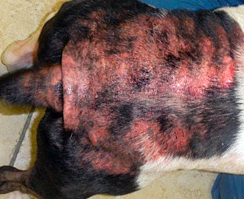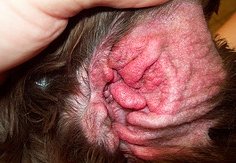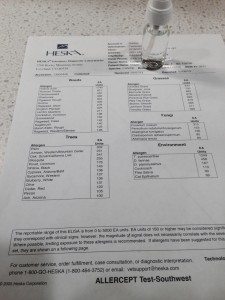Itchy skin is one of the most common reasons that a dog or cat will come to see us, especially at this time of the year. But exactly what makes a pet itch can vary from animal to animal. Here we will cover the most common culprits of itchy skin in pets.
Fleas - everyone hates them and no one thinks that their pet has them.
The truth is, especially with the summer fast approaching, if your pet is not on a comprehensive flea control program (one that protects not only against adult biting fleas but flea eggs as well), you probably have fleas on your pet and/or in your home. “But I don’t see any fleas on my pet.” “I haven’t been bitten by any fleas, so I know my pet doesn’t have them.” “I just don’t like using drugs/chemicals on my pet.” And the ever-popular “My pet just doesn’t have fleas.” These are the most common comments from owners to explain why their pet is not on flea control. You can check out last month’s blog for the whole scoop on fleas, but suffice it to say that it is much more beneficial (and way less expensive!) to prevent fleas from ever becoming a problem than to have to react to an infestation. That said, we kinda get excited when a pet is itchy from fleas because there is a treatment plan so easy and so effective that that pet never has to be itchy again.
Food allergies can also cause some pretty intense itch. And again, don’t take this the wrong way but we love, love, LOVE it when pets are allergic to food. If the only thing that your pet is allergic to is a particular food ingredient (and it’s usually a protein, sometimes it’s corn, soy) then all we have to do is avoid that food and they are itch-free! Of course arriving at a solid diagnosis of a food allergies takes time and a lot more effort and will-power than most owners realize. The exclusively food-allergic pet is itchy all year round - there is no seasonality to his itch. (S)he is also typically itchy at certain spots on the body - “ears and rears” tend to be the most common sites of itch for food allergies, but sometimes the itch manifests elsewhere.
And to discover just what your pet might be allergic to requires a very strict and lengthy diet trial. First we need to slowly transition the pet to a limited ingredient diet that does not contain any protein source that the pet has eaten in the past. These “novel protein diets” are usually kangaroo, quail, pork or rabbit-based but the most important thing is that it should be something that your pet has never eaten before. Next the diet trial needs to be S-T-R-I-C-T. (S)he can eat only this food and other approved-by-the-vet treats. For example if your pet is on a duck diet trial, (s)he can not also have the tiny chicken morsel from your dinner plate from time to time, or the rare beef liver treat at the vet or even flavored medications (unless they are duck-only flavored). Treats should be duck based - freeze-dried duck hearts would be perfect. Regardless of the diet, peeled baby carrots, apple and fresh watermelon are usually healthy “legal” treats to give a dog during a diet trial. Lastly this diet trial needs to last at least 6 weeks - most veterinary dermatologists will say at least 8 weeks. And of course the definitive way to nail down a diagnosis of food allergies is to then offer the old proteins back to the pet one by one and watch to see which protein triggers the itch again. Many times the pet improves so much on the novel protein diet, that we don’t have a huge need to make the pet itchy on purpose just to arrive at a diagnosis.
Atopic dermatitis (aka dog/cat eczema triggered by an environmental allergy) is the most frustrating culprit for itchy skin, by far. How do you control your pet’s exposure to things like dust mites or grass? Nearly impossible! Many atopic pets find themselves at the vet several times a year for skin flare-ups. The most common and effective way to battle these flare-ups is usually with steroids and antibiotics. The steroids will control the itch and inflammation and make the pet more comfortable. The antibiotics will address the secondary skin infections that the pet has usually given him/herself as a results of all the itching. While this mixture of medications is usually very effective, it can eventually take a toll on the body, especially when used frequently. At DTLAvets we offer an environmental allergy blood test that examines the interaction between the pet’s blood and specific weeds, trees, grasses, fungi, and environmental organisms found in the southwest US. A report is generated and based on the results, we can then order customized immunotherpay serums for your pet. These immunotherapy serums come in increasing concentrations and slowly “teach” your pet’s immune system how to deal with those particular allergic triggers. The end result is a pet who flares up less often and therefore needs steroids and antibiotics less frequently. This desensitization process is costly and lengthy, often requiring 6-12 months before an owner notices results. But in a young dog or one who is not a good candidate for frequent steroids and/or antibiotics, it can definitely be worth it.
Lastly we can’t forget about those pesky bacterial and yeast infections that often accompany itch, whatever the cause. The importance of addressing these secondary infections cannot be overstated. If you ignore these secondary bacteria and fungi, the itch will absolutely continue, even if you’ve eliminated the primary culprit. Often a mixture of oral antibiotics and/or oral antifungals with medicated shampoos will be used to battle this component of the itch.
Itchy skin is frustrating. It’s uncomfortable for your pet. And it’s definatley worth having a meaningful conversation with a vet to create a plan for reducing or eliminating the itch. Call DTLAvets and let us help your pet live in healthier skin!


